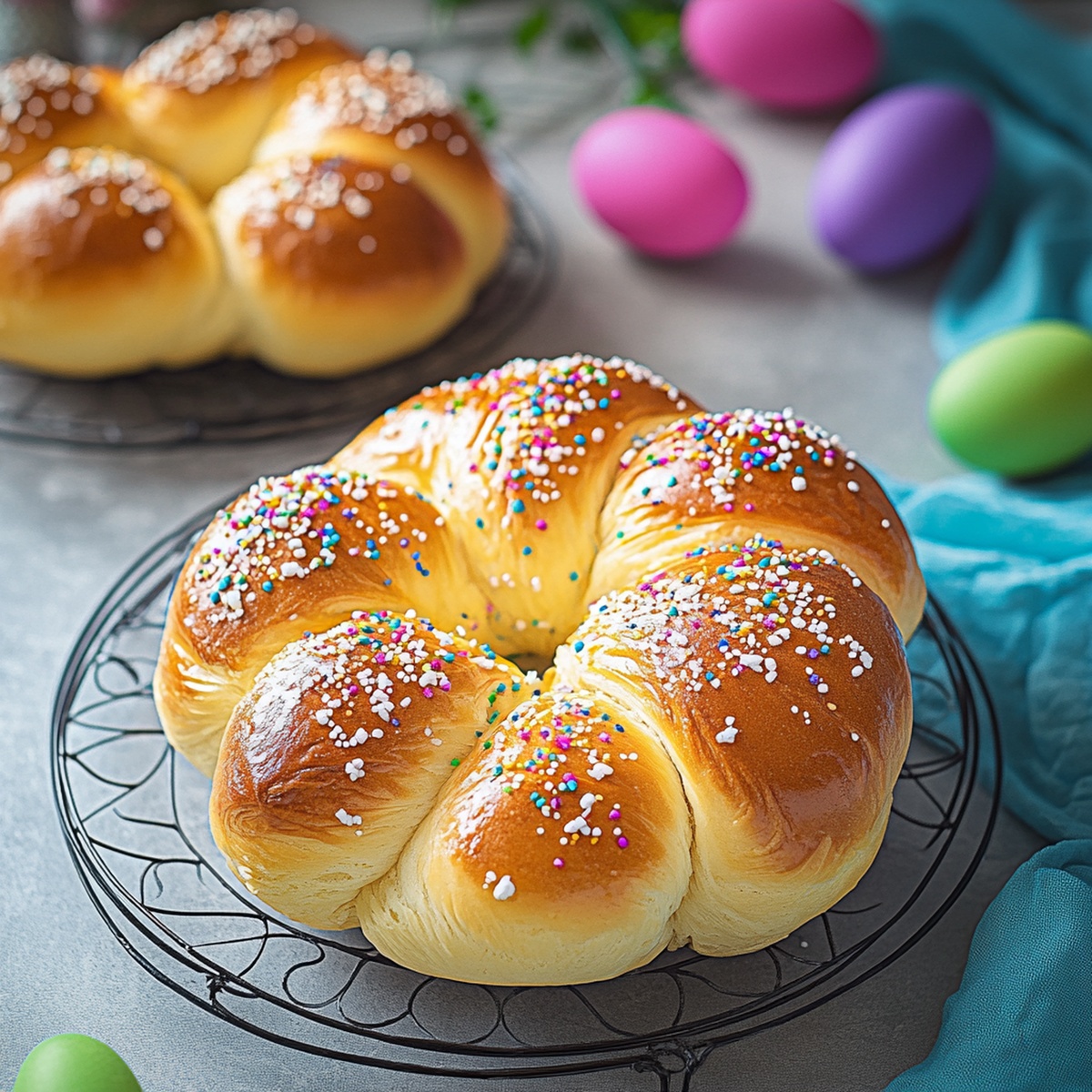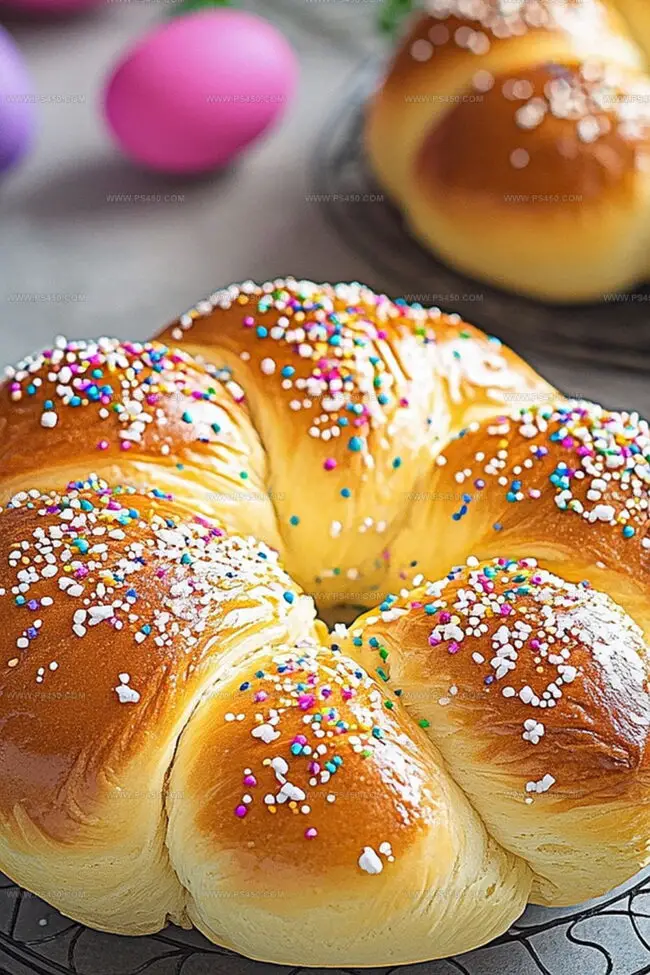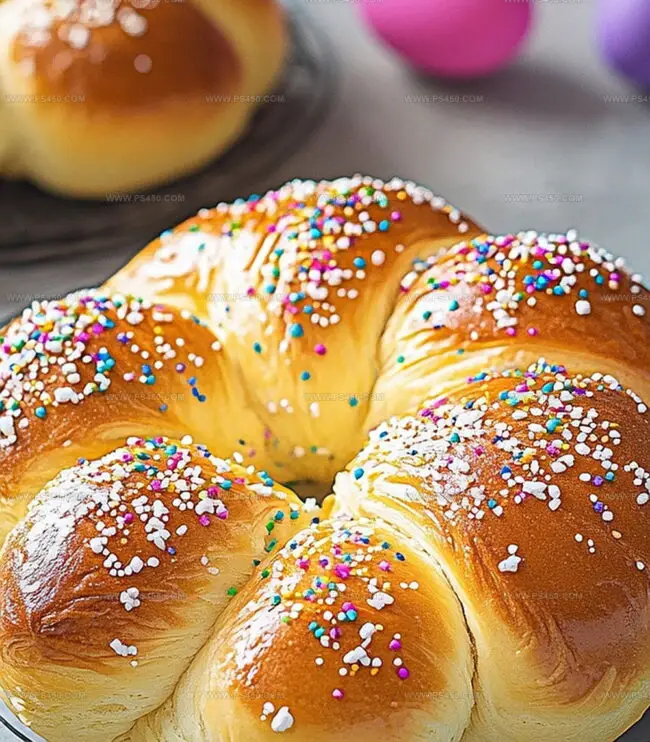Easter Tsoureki Recipe That’s Light and Fluffy
Crafting an authentic greek easter tsoureki weaves together generations of culinary tradition with delightful sweetness.
Soft, aromatic bread emerges from kitchen counters across greece during holiday celebrations.
Fragrant orange zest and mahlepi spices dance through delicate dough, creating memories that linger beyond each bite.
Rich butter and eggs blend into a tender crumb that whispers stories of family gatherings.
Braided with care and adorned with vibrant red eggs, this bread symbolizes renewal and hope.
Mastering tsoureki connects you to centuries of greek cultural heritage.
Join me in recreating this beloved easter treasure that transforms simple ingredients into something magical.
Why Easter Tsoureki Is A Soft, Sweet Holiday Classic
What Goes Into Easter Tsoureki
Bread Base:Aromatic Spices and Flavors:Binding and Enriching Ingredients:How To Bake Easter Tsoureki At Home
Step 1: Awaken The Yeast
Grab some warm milk and sprinkle yeast with a touch of sugar. Let this magical mixture sit and bubble for about 10 minutes until it looks wonderfully frothy.
Step 2: Create Aromatic Dough Base
In a spacious mixing bowl, blend together:Create a cozy center well and pour in the activated yeast, whisked eggs, and melted butter. Stir everything until a soft, fragrant dough emerges.
Step 3: Massage The Dough
Spread some flour on your work surface and lovingly knead the dough. Spend 8-10 minutes transforming it into a smooth, elastic masterpiece. If you prefer, use a stand mixer with a dough hook for 5-7 minutes.
Step 4: First Resting Period
Nestle the dough into a greased bowl, drape a damp cloth over it, and let it rest in a warm, cozy spot. Allow it to rise and double in size over 1½-2 hours.
Step 5: Craft Beautiful Braid
Gently deflate the dough and divide it into three equal sections. Roll each piece into a long 16-inch rope. Weave these ropes into a beautiful braid, tucking the ends underneath. Transfer your creation onto a parchment-lined baking sheet.
Step 6: Second Rising Moment
Cover the braided masterpiece with a soft towel. Let it rise again for 30-45 minutes until it looks delightfully puffy.
Step 7: Prepare The Oven
Warm up your oven to 350 degrees Fahrenheit.
Step 8: Add Golden Touches
Lovingly brush the dough with beaten egg to create a stunning golden sheen. Sprinkle sliced almonds across the top. For a traditional twist, gently nestle red-dyed eggs into the braid.
Step 9: Bake To Perfection
Slide the tsoureki into the oven and bake for 25-30 minutes. Look for a gorgeous golden-brown color. Tap the bread – if it sounds hollow, it’s ready!
Step 10: Serve With Love
Allow the tsoureki to cool slightly, then slice and share this delectable Greek bread with family and friends.
Pro Tips For Beautifully Braided Easter Tsoureki
How To Store Easter Tsoureki Without Drying It Out
What To Enjoy With Easter Tsoureki
Tasty Variations For Easter Tsoureki Bakers
Your Questions About Easter Tsoureki Answered
Tsoureki is a traditional Greek sweet bread deeply connected to Easter celebrations, symbolizing resurrection and new beginnings. Its unique flavor comes from mahleb and mastic spices, which give it a distinctive aromatic taste that represents the joy of the holiday.
The red eggs symbolize the blood of Christ and represent renewal and life. They are a powerful Christian symbol traditionally embedded in the bread, signifying Christ’s resurrection and serving as a meaningful cultural and religious tradition during Easter.
The combination of mahleb (ground cherry kernel spice) and mastic (resin from Greek island trees) creates the bread’s unique, slightly sweet and aromatic taste. These traditional spices are essential to authentic Greek tsoureki, providing a complex and memorable flavor that sets it apart from other sweet breads.
While tsoureki requires some patience and technique, it’s achievable for intermediate bakers. The key is understanding the yeast activation, proper kneading, and allowing sufficient rising time. With practice, home bakers can successfully create this beautiful braided bread that looks impressive and tastes delicious.
Print
Easter Tsoureki Recipe
- Total Time: 3 hours
- Yield: 12 1x
Description
Greek Easter bread tsoureki weaves magical traditions from Mediterranean kitchens into a sweet, fragrant celebration of heritage. Delicate braided dough enriched with mahlepi and mastiha spices promises festive moments that connect generations of Greek families.
Ingredients
Main Ingredients:
- 4 cups bread flour
- 3 large eggs
- 1 cup sugar
- 1 cup warm milk
Flavor Enhancers:
- ½ cup unsalted butter, melted
- 1 teaspoon ground mahleb
- ½ teaspoon ground mastic
- Zest of 1 orange
Finishing and Garnish:
- 2 ¼ teaspoons active dry yeast
- ½ teaspoon salt
- 1 egg (for egg wash)
- 2 tablespoons sliced almonds
- Red-dyed hard-boiled eggs (optional)
Instructions
- Awaken the yeast by dissolving it in tepid milk, blending with a touch of sugar. Allow the mixture to transform into a frothy, bubbling elixir for approximately 10 minutes.
- Craft a flavor foundation by combining flour, sweetener, aromatic mahleb, fragrant mastic, vibrant orange zest, and a pinch of salt in a spacious mixing vessel. Create a central crater and introduce the effervescent yeast mixture, whisked eggs, and liquefied butter. Gently integrate ingredients until a supple, cohesive dough emerges.
- Transfer the dough to a lightly dusted surface and knead with rhythmic motions. Work the dough persistently for 8-10 minutes, developing a smooth, elastic texture. Alternatively, utilize a stand mixer with a dough hook, churning on medium velocity for 5-7 minutes.
- Nestle the dough into a generously greased receptacle, drape with a moisture-laden cloth, and position in a nurturing, warm environment. Allow the dough to luxuriate and expand, nearly doubling its original volume within 112-2 hours.
- Deflate the risen dough with a gentle punch. Segment into three equal portions, rolling each into elongated 16-inch strands. Intertwine the ropes in a delicate braid, carefully tucking the extremities underneath. Carefully transfer the woven loaf onto a parchment-lined baking sheet.
- Envelop the braided creation with a soft towel, permitting a second rise of 30-45 minutes until it becomes subtly voluminous.
- Calibrate the oven to 350F (175C), preparing a warm sanctuary for the soon-to-be tsoureki.
- Apply a lustrous egg wash, transforming the surface to a golden hue. Cascade sliced almonds across the top. For a traditional flourish, delicately nestle crimson-hued eggs into the braid’s crevices.
- Commit the tsoureki to the heated oven, baking for 25-30 minutes. Seek a rich golden-brown complexion and listen for a hollow percussion when gently tapped.
- Extract the tsoureki, allowing it to descend to ambient temperature. Slice and serve this aromatic Greek delicacy, celebrating its intricate layers and festive spirit.
Notes
- Create a stable yeast environment by ensuring the milk is warm (not hot) to activate without killing the yeast.
- Add extra flavor complexity by toasting mahleb and mastic before mixing into the dough for deeper aromatic notes.
- Adjust rising times based on kitchen temperature, using a warm draft-free spot like inside a turned-off oven with the light on.
- Customize the bread by experimenting with alternative toppings such as pearl sugar, sesame seeds, or orange-infused powdered sugar for different textures and flavors.
- Prep Time: 30 minutes
- Cook Time: 30 minutes
- Category: Desserts, Breakfast
- Method: Baking
- Cuisine: Greek
Nutrition
- Serving Size: 12
- Calories: 260
- Sugar: 20 g
- Sodium: 130 mg
- Fat: 9 g
- Saturated Fat: 5 g
- Unsaturated Fat: 4 g
- Trans Fat: 0 g
- Carbohydrates: 38 g
- Fiber: 1 g
- Protein: 6 g
- Cholesterol: 50 mg




Emily Morgan
Food Critic & Kitchen Tips Specialist
Expertise
Global Food Exploration & Critique, Simple Kitchen Hacks & Time-Saving Tips, Presentation & Plating Techniques, Culinary Research & Storytelling.
Education
New York University
Emily Morgan has journeyed across the globe, collecting culinary secrets that turn everyday ingredients into impressive meals.
Based in Seattle and armed with a Journalism degree from NYU, she blends thorough research with a flair for presentation, ensuring every dish looks just as good as it tastes.
Focusing on fresh flavors, simple methods, and a bit of fun, Emily shows home cooks how to elevate their daily cooking without fancy gadgets or complex steps.